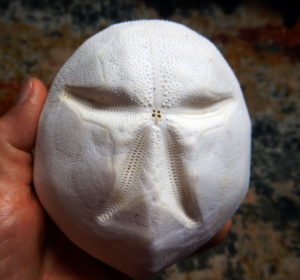
A heart urchin skeleton from an Australia beach, the same species as Hawaii’s heart urchin. Grows to 7 inches. ©Susan Scott
November 20, 2020
One of my heartbreaks about the Star-Advertiser cancelling my weekly Ocean Watch column was losing my fellow marine biology enthusiasts whose questions and comments kept me learning as well as entertained. Happily, subscribers to this website continue keeping in touch. Last week, reader Noriko wrote:
“Recently a diver friend mentioned seeing heart urchins for the first time in Oahu waters, and then suddenly seeing them several times in a row. To me they resemble sea biscuits, but I suppose irregular echinoids share some characteristics. Mahalo for any light you might be able to shed on this critter.”
Most of us know a sea urchin when we see one. (I didn’t always. I thought that the long-spined urchins, or wana, I saw during my first-ever snorkeling experience were cactuslike plants.) The animals look like pin cushions with various “pins,” called spines, poking out of their domelike skeletons. Urchin is an old word for hedgehog, a bristly little mammal with a piglike snout, common in Europe’s hedges.
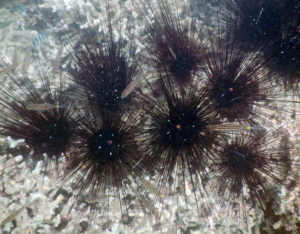
Long-spined sea urchins with cardinal fish sheltering among sharp spines. New Caledonia. ©Susan Scott
The calcium carbonate skeleton that covers and protects a sea urchin’s internal organs is called a test, from the Latin word, testa, meaning a tile or shell. Sea urchin tests are a series of interlocking plates, covered with holes and bumps that radiate from the mouth, on the flat bottom, to the anus, on the center top. The animals tube feet poke out of the holes, and the spines attach to the bumps.
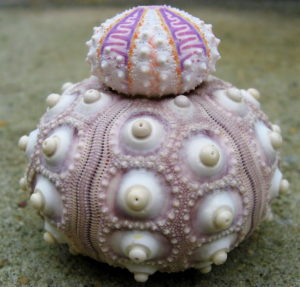
Outstanding oceanic ornaments: The striking lower test is from the Sputnik urchin, Phyllacanthus imperialis. On top is a rare, unnamed sea urchin test retrieved 1,000 feet deep by a research vessel off New Caledonia. Wikimedia, Creative Commons, photo shared by Steve Jurvetson.
Sea urchin development, and the animals’ tests, are of great interest to researchers, who recently discovered 110 different proteins in the structure of one sea urchin skeleton.
The world’s oceans host about 900 sea urchin species, with about 75 in Hawaii. The globular ones, such as wana and slate pencils, are called regular urchins.
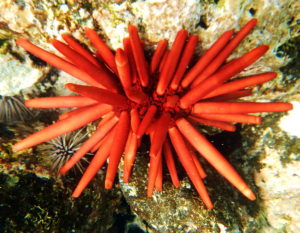
A regular sea urchin, called a slate pencil, off Kailua-Kona. ©Susan Scott
Another group with side-to-side symmetry are called irregular urchins. We know them as sand dollars, sea biscuits, heart urchins, and nearly endless other common names. Some of my favorite nicknames are sea potatoes (Singapore) and sea cookies, (New Zealand.)
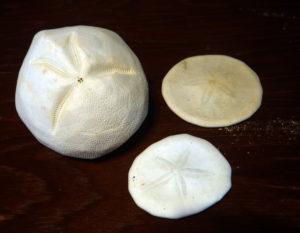
A heart urchin (left) from an Australia beach. The two large sand dollars are from a Mexico beach in the Gulf of California. ©Susan Scott
Irregular sea urchins live their entire lives under the sand, scooting around on their tube feet in search of anything edible, either plant or animal, dead or alive. The spines of irregular urchins are short and pointed back, enabling the buried creatures to better plow forward. Some irregular urchin species grind coarse sand into fine particles, a factor adding to Hawaii’s powdery beaches.
The photos below show some of the hundreds of live sand dollars Craig and I found at low tide on a remote island beach in Australia’s Great Barrier Reef National Park.
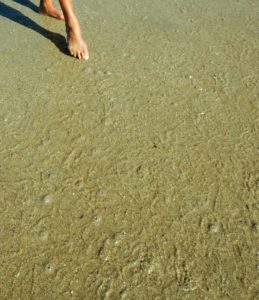
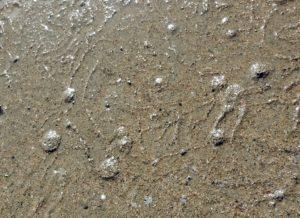
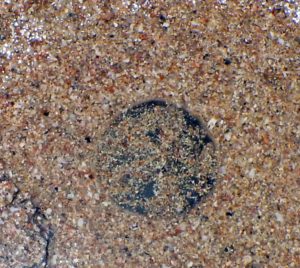
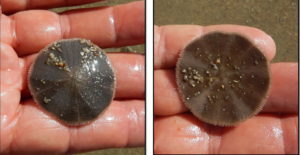
Hawaii’s heart urchins are the largest of our irregulars, growing to about 7 inches long. We almost never see heart urchins alive, but rather find their skeletons on the ocean floor or on beaches. Tests grow fragile after the creature has died, and often crumble in the hand. The species we see in Hawaii ranges throughout the Indian and Pacific Oceans.
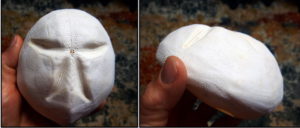
Urchins breathe through their feet. The 5 petal shapes on top of heart urchin, sand dollar, and sea biscuit tests are holes for tube feet specialized for respiration. ©Susan Scott
Other irregular urchins in Hawaii’s waters grow only an inch or two long, prime pickings for spotted eagle rays and some starfish.
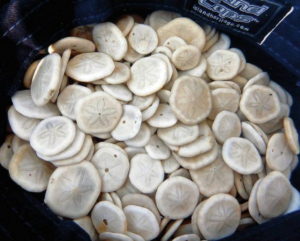
Craig and I filled my baseball cap with a fraction of thousands of coin-sized sand dollar tests we found in Horseshoe Bay, Magnetic Island, Great Barrier Reef National Park. The holes on the edges are from carnivorous snails that bore into the urchins and suck out the interior organs, leaving the skeletons intact. ©Susan Scott
Sea biscuits look like inflated sand dollars, but aren’t as tall as heart urchins. Sand dollar and sea biscuit skeletons are common on beaches in some parts of the Pacific, but not in Hawaii.
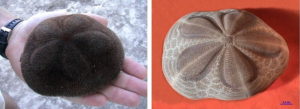
A live sea biscuit (left) and its test. North Carolina Museum of Natural Sciences. http://b-w-williams-invert.weebly.com/
Thank you, Noriko, and other readers, for your great questions and comments. You, my friends, are keeping Ocean Watch alive. Please share this site with fellow fans of marine biology.
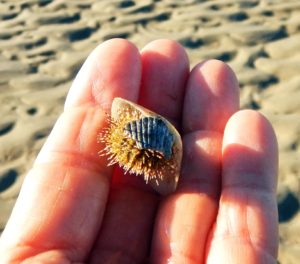
A tiny, red-and-white-spined collector urchin I rescued when the tide went out at Pancake Creek, Queensland, Australia. The urchin was hunkered down in a clamshell while holding a snail shell fragment over its “head.” ©Susan Scott